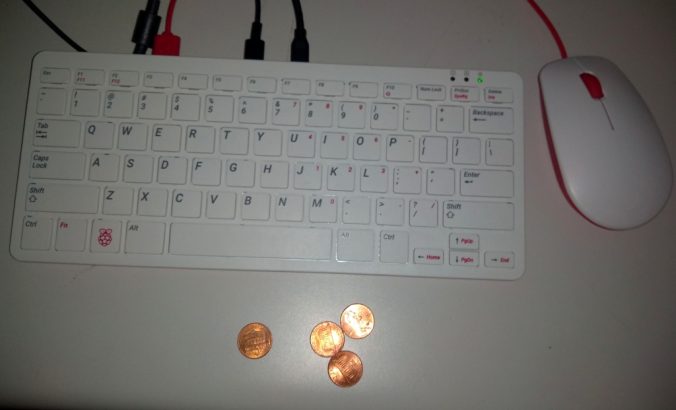How I got baked into this…
I was offered the short-term use of a brand new Raspberry Pi 400 Personal Computer Kit, and leapt at the chance. The kit comes with the actual Raspberry Pi 400, a matching mouse, a power supply a 16 Mb MicroSD memory card and a cable for connecting an HDMI monitor or TV to a Micro-HDMI port on the Pi.
I have been a longtime users and fan of the Raspberry Pi family of single board computers. These little boards can be used as regular computers, as the “brains” in a robot or drone, as the controller for a scientific or industrial system, as a file server, or about anything you can think of.
Part of what I love is that they come as a simple little board and anything else you want you can make or buy and add on to the board. This leaves a lot to the imagination, and the original purpose of the Raspberry Pi was as an educational tool, so imagination is key.
So I had a bit of skepticism about a Raspberry Pi that was a complete computer, in a case that was also a keyboard, and even (in the current configuration) as a kit which just needs a monitor added.
First taste of Pi
It’s really too cute – a tiny keyboard, white on top and red underneath, no bigger than the keyboard area on a small laptop. And, with a computer inside it. The attractive package is also solidly built and solid feeling. The Super Key (“Windows key” to some people) has a raspberry on it. It has led lights for power, capslock, and numlock.
On the back there are ports for gigabyte wired Ethernet, USB 2.0, two USB 3.0, USB C (for power-in only), two Micro-HDMI ports for connecting monitors, a slot for a MicroSD card (used as main storage memory), and a 40-pin GPIO port that can be configured for anything a tinkerer can think of.
Inside is a quad-core 64-bit ARM processor running at 1.8 GHz. Bluetooth connectivity, and b/g/n/ac wireless.
As I noted above, the package I borrowed includes the power supply, HDMI cable, memory card, and mouse. It also has a well-written 250 page book on getting started with the Pi 400.
Rolling out the Pi crust
One way that this system still allows for the imagination to roll free is that you can have some choice in operating systems. The kit comes with a memory card that boots into a menu that allows you to choose and install an operating system. I chose the default, Raspberry Pi’s own RaspberryPi OS (PiOS), a version of Debian Linux with small modifications for Raspberry Pis.
First run/setup was easy, mostly automatic, with an update and a restart following.
After rebooting, it’s ready to use. It comes with a small but useful component of software including Chromium Browser (open-source version of Chrome), LibreOffice Suite, some games and some programming tools, VLC for multimedia, etc. One interesting add-in is Wolfram Mathematica software that they put in under a special license from Wolfram that allows non-commercial use of this scientific software.
It’s running an up-to-date version 5.10 Linux kernel. Overall responsiveness seems pretty good. It connected to my network file server easily (some systems don’t). Even with software that asks a lot of the system (for example, LibreOffice, or browsers) it moves along at a pretty acceptable pace.
While the small selection of software is pretty useful, the “Recommended Software” entry in the menu doesn’t give much extra. I immediately added Synaptic, a powerful tool though a little less that user-friendly tool for adding more software packages. I had to add Synaptic from the command line (“sudo apt install synaptic”) and then could use it to add more software like Mozilla Firefox to replace the Chromium browser, and other favorites to the user’s tastes.
I also tried out a 4K monitor, to see if it would work, and it did but only at 30 Hz, a slow refresh rate.
Did you try other flavors?
I also tried the Pi400 with Manjaro ARM, which has been my favorite distro for ARM-based computers lately. It is on my Pi4 and my PinebookPro laptop. For the Pi400, I used it with KDE Plasma desktop environment. Since Manjaro is a “rolling” release, it updates frequently and supports the latest hardware and software.
The installed software is similar to that of PiOS, but does have Mozilla Firefox in place of Chromium, and, unlike PiOS, includes GIMP for higher end graphics editing. Software management is not user-friendly, but the provided package manager (PAMAC) is very comprehensive.
So all in all how did the Pi taste?
It’s worth repeating that it’s a pretty cute little unit! It is also well-made, pretty snappy, and supports a lot of software and hardware. While the original modular Raspberry Pi form factor still is more appealing to me, I concede that this would be a better choice for anyone who wants a small, inexpensive computer and doesn’t want to do a lot of customization.
The complete kit is available for about $100 in a variety of online merchants.

Tim
Very good and professional review. Suggest that you send it to Bill Rummff, John Wickliffe and APCUG.
Thanks
GarretyGsr